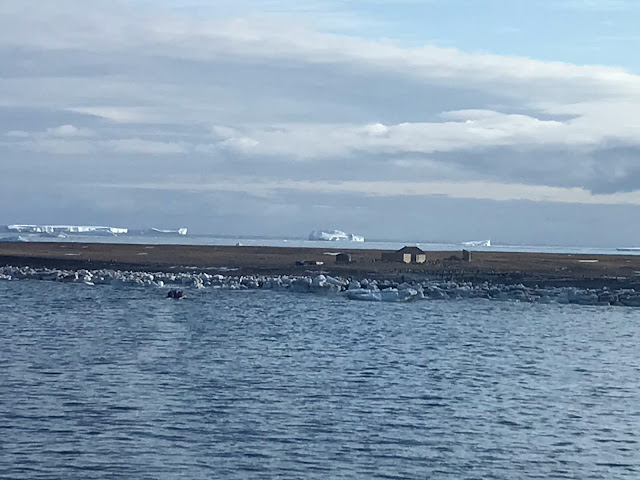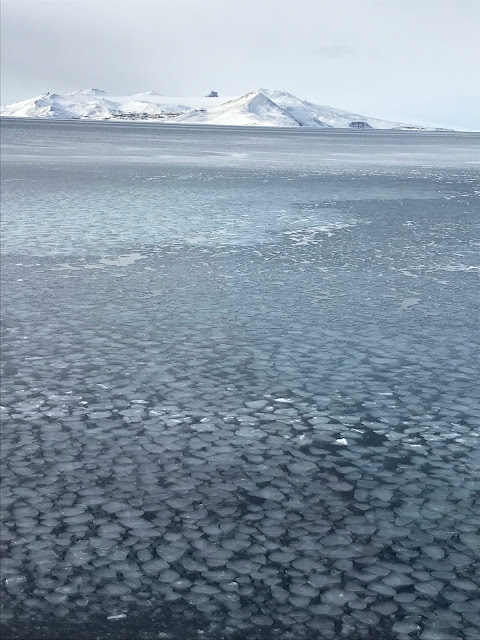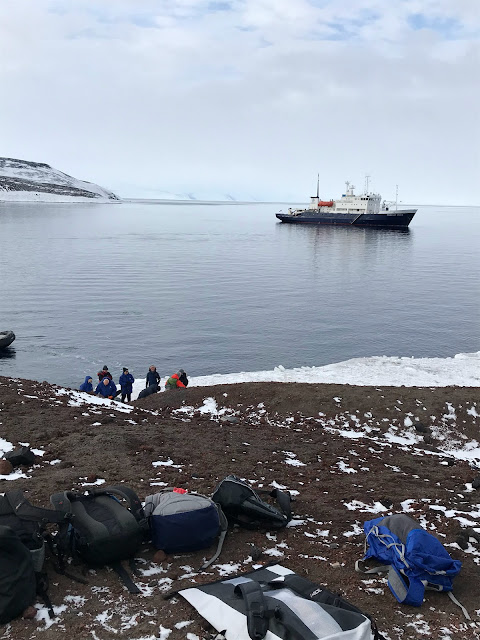I'm still in the process of rebuilding this blog about our trip to Antarctica in 2020. Please be patient and stay tuned.
Antarctica 2020 In the wake of Scott & Shackleton
Wednesday, 28 December 2022
Tuesday, 25 February 2020
February 25 One last try!
We discovered early this morning that there was another ship in the Bay. And that’s a first on this voyage - everyone else is way over east visiting the Antarctic Peninsula, lucky us! Our Expedition Leader was keen to make a landing on the beach to see Borchgrevink’s hut so we were called to an early breakfast in order to maximise the time we could spend in Robertson Bay before heading north to Macquarie Island.
Samuel got two boatloads landed through the surf but then called it off as it was proving just too dangerous. One zodiac got swamped and waves were breaking over people - no wonder they pulled up stumps and retreated to the ship. But they took all the zodiacs out to cruise around the beach later.
 |
| It looks fairly innocuous, but it was treacherous between the icebergs and shore |
The long-awaited Polar Plunge took place before lunch that day and 11 stalwarts leapt in. In spite of my intentions, I decided against it - I had a cold and the weather was icy. And Lindsay. in view of his recent surgery, was advised against it by the ship’s doctor. And we were being stalked by a Leopard Seal - they have been known to attack humans particularly if they are wearing black!!! That would have been me - a good decision for me!
 |
| That's Samuel in the zodiac ready to help if needed. Note the ice in the water! very cold |
 |
| That splash was Al, one of our chefs, who jumped off from deck 4. Brave crazy boy! |
Monday, 24 February 2020
February 23-24 Heading back north
We revisited the desolate Inexpressible Island on our return journey back north. The weather was a little kinder than four days earlier so a group of people went ashore. The sea was still a bit too rough for me so I, and many others, decided against it, but I wished I had joined them as this island has some of the best examples of lichens in this entire region and also some amazing rocks as well as the odd penguin. I say ‘odd’ because the landing party came across an Emperor penguin on land and that’s most unusual. These penguins rarely go ashore living their entire life on sea ice, ice shelf or at sea.
 |
| It was getting colder by the day! |
 |
| Possession Island - a quite magnificent and stark scene |
 |
| Last year's sea ice starting to clump |
 |
| We sailed past massive icebergs adrift in a fast-freezing sea |
 |
| Cape Adare looked so different from when we arrived a mere 7 days earlier. |
Sunday, 23 February 2020
February 22 Earth’s last frontier?
 |
| Cape Crozier is on the east and is almost engulfed by the Ross Ice Shelf |
 |
| The edge of the Ross Ice Shelf from the front window of our cabin |
 |
| You can see where chunks of the ice shelf have calved off |
Saturday, 22 February 2020
February 21 McMurdo Sound
That same day, after visiting Discovery Hut, we sailed further south in McMurdo Sound to Scott Base, NZ's base. It was quite picturesque as it was snowing gentle flakes. A number of people went ashore to inspect the old huts. We then spent the rest of the afternoon and evening sailing close to the McMurdo Ice Shelf looking for wildlife. We saw Adelie and Emperor Penguins and Weddell and Crab-eater Seals and a few Minke Whales plus other beautiful creatures. It was glorious.
 |
| The green structures are part of the NZ Antarctic base - Scott's Base. |
 |
| We were intrigued to discover that there's a huge runway along the McMurdo Ice Shelf. |
 |
| Everyone, crew included, were hanging over the ship side as we touched the ice shelf |
 |
| It was exciting crunching through the growing ice sheets |
 |
| Emperor Pengions on the left, Leopard Seal on the right |
 |
| We cut a crazy path through the ice as we tracked these glorious creatures |
Friday, 21 February 2020
February 21 Heading further south to Discovery Hut
Over a few days we visited the places on Ross Island where the expedition huts built over 100 years ago by Scott and Shackleton’s early expedition teams still stood. Amazing! We were fortunate to be able to land. A month ago, this same ship couldn’t get to some of the spots because of high seas and winds. Lucky us! All the while, Mt Erebus loomed nearby, quietly puffing out ‘steam’. The scenery was always spectacular!
 |
| There were wind turbines on the Hill to replace the former nuclear power station |
There was little wind and the temperature was a balmy -4C as we dropped anchor that morning to visit Discovery Hut. This hut had been built on Scott’s first expedition in 1902. We landed close to the huge US base, McMurdo Station, which houses over 1000 personnel, some all year round. We weren’t invited in, but we did chat to a few guys out for a walk.
 |
| It was another icy landing at Hut Point Peninsula |
 |
| A pile of seal blubber and bones used to make soup etc - yummy! |
 |
| 100-odd year old expedition biscuits. Hard as wood but sufficient for a meal with a hunk of cheese. |
 |
| A colony of Adele Penguins |
 |
| Communications station perched high on a ridge behind the US McMurdo Station. |
Thursday, 20 February 2020
February 20 We are the most southern ship in the world!
 |
| Satellite image of Ross Island (L) showing the two hut locations we visited. |
 |
| A beach landing on ice-encrusted black sand beach . |
 |
| Weird and fanciful mushroom-like formations carved by wind and water lined the beach |
 |
| Scott's hut in the distance |
 |
| Lean-to stables adjoined the hut. Against them is propped one of the original wooden sledges |
 |
| Of course we lined up for the obligatory photo. |
 |
| Fascinating to read the labels on the boxes of stores. We even found a chest of sea-biscuits |
 |
| Top R strips of seal blubber, Bottom R a sleeping bags made from reindeer hide, Bottom L Scott's 'office' complete with penguin ready for dissection. |
 |
| Shackleton's hut - a pale structure centre image. To right of the hut was the protected penguin colony. |
 |
| It was a glorious albeit icy scene with a ghostly Mt Erebus in the background. |
Updates still to come
I'm still in the process of rebuilding this blog about our trip to Antarctica in 2020. Please be patient and stay tuned.
-
As we travelled further south, the temperature gradually dropped lower and lower until we woke to ice on the inside of our cabin window, ici...
-
That same day, after visiting Discovery Hut, we sailed further south in McMurdo Sound to Scott Base, NZ's base. It was quite picturesque...
-
Satellite image of Ross Island (L) showing the two hut locations we visited. Having passed Cape Royds on Ross Island with a promise to retu...












